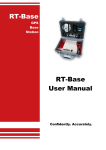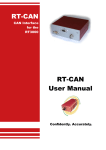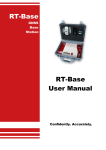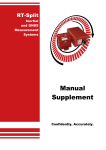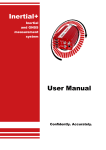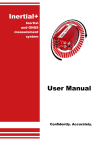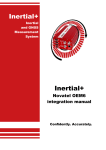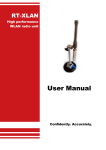Download RT-ANA User Manual
Transcript
RT-ANA Analogue Interface for the RT3000 User Manual Confidently. Accurately. Legal Notice Information furnished is believed to be accurate and reliable. However, Oxford Technical Solutions Limited assumes no responsibility for the consequences of use of such information nor for any infringement of patents or other rights of third parties which may result from its use. No license is granted by implication or otherwise under any patent or patent rights of Oxford Technical Solutions Limited. Specifications mentioned in this publication are subject to change without notice and do not represent a commitment on the part of Oxford Technical Solutions Limited. This publication supersedes and replaces all information previously supplied. Oxford Technical Solutions Limited products are not authorised for use as critical components in life support devices or systems without express written approval of Oxford Technical Solutions Limited. All brand names are trademarks of their respective holders. Copyright Notice © Copyright 2004, Oxford Technical Solutions. Revision Document Revision: 040510 (See Revision History for detailed information). Contact Details Oxford Technical Solutions Limited 77 Heyford Park Upper Heyford Oxfordshire OX25 5HD Tel: 01869 238 015 Fax: 01869 238 016 http://www.oxts.co.uk mailto:[email protected] 2 Oxford Technical Solutions RT-ANA User Manual Table of Contents Introduction 4 Scope of Delivery 5 Specification 6 Warranty 7 Functional Overview 8 Configuration 9 Command Syntax 11 Connections 15 Revision History 19 Revision: 040510 3 Introduction The RT-ANA unit is an interface converter that accepts CAN messages from the RT3000 and converts them to analogue voltages. The RT-ANA has up to 16 analogue output channels with a range of ±10V. The RT-ANA uses precision 16-bit DACs and precision op-amp drivers to ensure the highest levels of accuracy can be achieved. The outputs are presented on 16 BNC connectors and on a 25-way D-type connector. Either output can be used and they are connected internally. The configuration for the analogue outputs is performed in the RT3000; the RT-ANA decodes four, 8-byte CAN messages and turns them in to voltages. The only user configuration parameters are the CAN baud rate and the fast-update mode. The RT-ANA includes galvanically isolated power supplies on the analogue side to ensure that there are no ground loops. This power supply is not intended to have large D.C. offsets between the earth and the analogue outputs since the EMC filters have a working voltage of 25V. The isolation is suitable for use in vehicles. The RT-ANA has an indicator LED to show that it is receiving CAN messages and working correctly. 4 Oxford Technical Solutions RT-ANA User Manual Scope of Delivery Table 1, below, lists all the items that are delivered with each RT-ANA unit. Table 1. Summary of the RT-ANA Components Qty Description 1 RT-ANA Unit 1 77C0002B Power Cable 1 14C0037A CAN Cable 1 Null Modem Serial Cable (for configuration) Figure 1. RT-ANA Components Revision: 040510 5 Specification The technical specification of the RT-ANA unit is shown in Table 2, below. Table 2. Technical Specification Parameter Specification Input CAN Calculation Delay1 6.6ms (low latency mode), 16.6ms (fast-update mode) Outputs 16 Analogue Channels Output Rate 100 Hz (low latency mode), 1.6kHz (fast-update mode) Output Range ±10V Output Accuracy 1mV Output Resolution 16-bits, 320mV Power 3W, 9 – 18V d.c. Operating Temperature 0 to 60°C Relative Humidity 95%, non-condensing Shock (Survival) 1000g, 5 ms half-sine Note 1: Delays depend on the CAN bus, these figures assume a 1MBit/s CAN bus speed. Add an additional 1.8ms for a 500kBit/s CAN bus. 6 Oxford Technical Solutions RT-ANA User Manual Warranty Oxford Technical Solutions Limited warrants the RT3000 products to be free of defects in materials and workmanship, subject to the conditions set forth below, for a period of one year from the Date of Sale. ‘Date of Sale’ shall mean the date of the Oxford Technical Solutions Limited invoice issued on delivery of the product. The responsibility of Oxford Technical Solutions Limited in respect of this warranty is limited solely to product replacement or product repair at an authorised location only. Determination of replacement or repair will be made by Oxford Technical Solutions Limited personnel or by personnel expressly authorised by Oxford Technical Solutions Limited for this purpose. In no event will Oxford Technical Solutions Limited be liable for any indirect, incidental, special or consequential damages whether through tort, contract or otherwise. This warranty is expressly in lieu of all other warranties, expressed or implied, including without limitation the implied warranties of merchantability or fitness for a particular purpose. The foregoing states the entire liability of Oxford Technical Solutions Limited with respect to the products herein. Revision: 040510 7 Functional Overview The RT-ANA responds to four specific CAN-bus messages sent by the RT3000. Table 3, below, shows the default, factory configured identifiers used by the RT3000 and the RT-ANA. Table 3. CAN Identifiers used by the RT3000 and RT-ANA Identifer Channels 610h Channel 0 to 3 611h Channel 4 to 7 612h Channel 8 to 11 613h Channel 12 to 15 The RT3000 encodes the desired voltage of each channel into these CAN messages. All the configuration for the channel data is performed by the RT3000, not the RT-ANA. Status LED The Status LED on the front panel gives some indication whether the RT-ANA is operating correctly or not. The following paragraphs describe the operation of the Status LED. Power-Up. At Power-Up the LED is green but it quickly changes to red when the software in the RT-ANA boots. If the LED remains green after the power has been put on then the RT-ANA will not work correctly. Waiting for CAN. The LED will remain red until 100 valid CAN messages have been decoded. CAN messages not intended for the RT-ANA will not count and will not change the LED state. CAN Running. The LED will flash Orange/Off every 100 CAN messages (100 Orange then 100 Off). Since the RT3000 updates at 100Hz and there are 4 CAN messages per update, the LED will cycle with a frequency of 2Hz. 8 Oxford Technical Solutions RT-ANA User Manual Configuration There are two configuration parameters that may need changing by the user before operation begins. These are the CAN baud rate (so it matches the RT3000 and the other devices on the bus) and the fast-update mode. To configure the RT-ANA a serial terminal program is required. Windows comes with HyperTerminal, but other suitable programs can also be used. Using the Null-Modem Serial Cable, connect the Configuration port of the RT-ANA to a serial port a PC. Run your serial terminal program and configure the settings as listed in Table 4, below. Figure 2. RT-ANA Configuration Output at Start-up Revision: 040510 9 Table 4. Serial Terminal Settings Parameter Specification Baud Rate 19200 Data Bits 8 Parity None Stop Bits 1 Flow Control None Example from Hyperterminal Apply power to the RT-ANA, the terminal will respond as shown in Figure 3, below. 10 Oxford Technical Solutions RT-ANA User Manual Figure 3. RT-ANA Configuration Output at Start-up At Start-up the Dev Id is the version of software running in the RT-ANA unit. This may be required when contacting Oxford Technical Solutions for support. The user commands that the RT-ANA responds to are listed in Table 5, below. Table 5. RT-ANA Commands Command Function CONFIG Lists the configuration of the RT-ANA. CANBAUD Sets the CAN Baud rate in KBit/s. FASTUPDATES Sets fast-updates on or off. SAVECONFIG Saves the configuration to non-volatile memory. Command Syntax The syntax for each of the commands is listed below. Note that the commands are casesensitive; upper case is required or the RT-ANA will not accept the command. Some commands will not all take effect until next power-on. All commands need to be saved Revision: 040510 11 to non-volatile memory using the SAVECONFIG command or they will be forgotten when the power is removed. CONFIG command. The CONFIG command is used to list the settings in the RT-ANA box. The command will list all the configurations, not just the ones for the user. Do not change any configurations apart from the ones described here. Syntax CONFIG Example Response Config Version Valid: 60785645 CRC: EEA0489 CANBAUD 1000 CANID 0 610 CANID 1 611 CANID 2 612 CANID 3 613 DACCAL 0 4 61867 DACCAL 1 -21 61832 DACCAL 2 -15 61874 DACCAL 3 -15 61881 DACCAL 4 -3 61853 DACCAL 5 -4 61863 DACCAL 6 220 61345 DACCAL 7 -1 61870 DACCAL 8 -4 61870 DACCAL 9 1622 65501 DACCAL 10 -12 61881 DACCAL 11 0 61867 DACCAL 12 16 61846 DACCAL 13 -4 61877 DACCAL 14 -6 61846 DACCAL 15 -15 61881 FASTUPDATES OFF 12 Oxford Technical Solutions RT-ANA User Manual CANBAUD command. The CANBAUD command is used to change the baud rate settings of the RT-ANA. This setting does not become active until the RT-ANA is next powered on. Syntax CANBAUD <RATE> Valid values for <RATE> are listed in Table 6, below. Table 6. RT-ANA CAN Baud Rate Options <RATE> Baud Rate 1000 1 MBit/s 500 500 kBit/s 250 250 kBit/s 200 200 kBit/s Note: Other values will be accepted, but are not guaranteed to work correctly. FASTUPDATES command. The FASTUPDATES command is used to turn the fastupdates mode on and off. Syntax FASTUPDATES <STATE> Valid values for <STATE> are listed in Table 7, below. Table 7. RT-ANA fast-update states <STATE> Fast-update state ON Fast updates are on OFF Fast updates are off When fast updates are off the RT-ANA behaves as expected for an analogue output system. The 100Hz outputs are written directly to the DACs as quickly as possible. This results in the lowest output latency. In fast-update mode the output to the DACs is smoothed. Linear interpolation is used to ensure that the new value at the DACs is reached at the end of the 100Hz cycle. Figure 4, below, compares the outputs using the normal DAC update and fast-update mode. Revision: 040510 13 Figure 4. Fast-Update mode In fast-update mode the output is delayed by one extra cycle (extra 10ms), but then the DACs are updated at 1600Hz. This can allow for better timing between systems; although the delay is longer, it is known more accurately. If a system samples the lowlatency RT-ANA output at 100Hz then the timing is only known to 10ms. If it samples the fast-update RT-ANA output then it knows the timing to 0.6ms. For some applications the improved timing is more critical than the additional delay. An alternative is to use the low-latency mode and then have the acquisition system over-sample the signal from the RT3000. For example, if the RT3000 is sampled at 1kHz and the samples are filtered using a suitable reconstruction filter then the fastupdate mode is not needed and the low latency output can be used without any reduction in performance. (Note that the fast-update mode is a form of reconstruction filter. It is impossible to make a reconstruction filter work in real-time without a delay. But it is possible to use a reconstruction filter on the data post-mission in the acquisition software.) SAVECONFIG command. The SAVECONFIG command is required to save the configuration to non-volatile memory. The SAVECONFIG command takes a few seconds to run; it is essential that power is not removed during the SAVECONFIG command. Syntax SAVECONFIG 14 Oxford Technical Solutions RT-ANA User Manual Connections The RT-ANA should be connected to the RT3000 CAN bus as shown in Figure 5, below. Figure 5. RT-ANA Connections to RT3000 The pin assignments for the connectors on the RT-ANA are given in the following tables. Revision: 040510 15 Figure 6. RT-ANA Front Panel Connectors Table 8. Power Connector Pin Assignments Pin Cable Colour Description 1 Brown Power Supply 9–18 V d.c. 2 White Not Connected 3 Blue Ground 4 Black Not Connected Connector type: Hirschmann ELST 412 PG9. Also known as an E-serial M12 plug. 16 Oxford Technical Solutions RT-ANA User Manual Table 9. CAN Bus Pin Assignments Pin Description 2 CAN– (CAN Low) 3 Ground 6 Ground 7 CAN+ (CAN High) Notes: Other Pins not connected. There is no CAN bus termination resistor inside the RT-ANA. The CAN bus must have at least one 120R resistor between CAN– and CAN+. Connector type: 9-way D-type, male. Table 10. Configuration RS232 Pin Assignments Pin Description 2 Data Receive 3 Data Transmit 6 Ground Notes: Other Pins not connected. Use a standard Null-Modem serial lead to connect to a PC. Connector type: 9-way D-type, male. Revision: 040510 17 Table 11. Analogue Outputs (25-way) Pin Description 1 Analogue Ground 2 Channel 0 3 Channel 1 4 Analogue Ground 5 Channel 2 6 Channel 3 7 Analogue Ground 8 Channel 4 9 Channel 5 10 Analogue Ground 11 Channel 6 12 Channel 7 13 Analogue Ground 14 Channel 8 15 Analogue Ground 16 Channel 9 17 Channel 10 18 Analogue Ground 19 Channel 11 20 Channel 12 21 Analogue Ground 22 Channel 13 23 Channel 14 24 Analogue Ground 25 Channel 15 Connector type: 25-way D-type, male. 18 Oxford Technical Solutions RT-ANA User Manual Revision History Table 12. Revision History Revision 040510 Comments Initial Version Revision: 040510 19




















